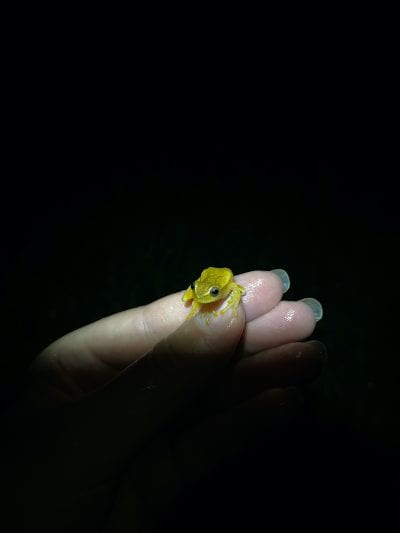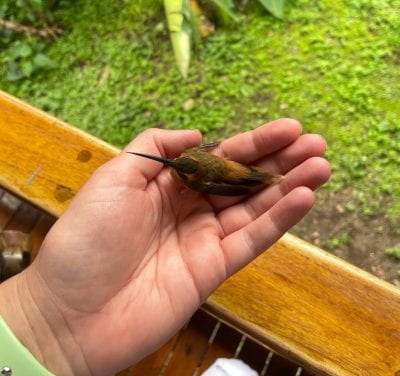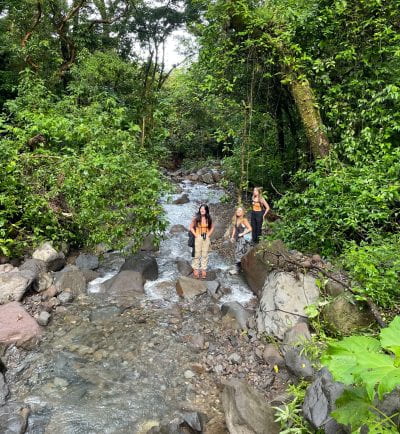Sakura Roberts is an honors fellow from Yukon, Oklahoma, studying biology with a pre-veterinary focus and a Spanish minor. She studied abroad in Costa Rica last summer and had the chance to conduct fieldwork with rare animals and plants. To Roberts, her time abroad also offered the unique chance to embrace new surroundings and grow by taking risks.
Every morning I woke up to the sound of yet another bird calling. That shrill, sharp chorus of chirps right outside my window at 5 a.m. was just what I envisioned when I signed up to study abroad. A natural alarm clock, my roommate would say happily, jumping right out of bed. She’s much more of a morning person than I am.
But of course there would be birds. Surrounded by lush flora and fauna, our campus was nestled in the foothills of the Monteverde Cloud Forest region of Costa Rica. It rained almost every day precisely around noon and by the end of the first week, we all had gotten accustomed to bringing a rain jacket everywhere we went. It was a unique place paired with people passionate about our natural world, and it was an experience I would never trade.
Embracing Unfamiliar Settings
When I looked for study abroad programs last fall, I had one thing on my mind: I wanted to experience a completely new environment. Gone with the cell reception, centralized air conditioning and familiarity. I then stumbled across a pamphlet briefly mentioning a tropical ecology and conservation program offered in Monteverde, Costa Rica. Immediately piquing my interest, I read more about the program’s courses and excursions. I knew instantly that the classes offered were ones I wanted to take: tropical biology, humans in the tropics, Spanish and independent research. The program was scheduled for 8 weeks with trips to different biological stations and reserves across the country, and I would soon be dropped into what would be a naturalist’s heaven.
It turned out to be one of the best experiences of my life. Not only were we located right in the middle of the rainforest with access to hiking trails, biodiversity and waterfalls, but the courses there were some of the most interesting I’ve had. My program was just eleven students, and my professors were local and were wonderful at teaching while we were out in the field. We visited local dairy and coffee farms that practiced sustainable agriculture, learned about the ecology of more than sixty different animals and plants in Costa Rica (which still barely covers what all is there), and spent time in the closest town to campus where we could try different foods from local sodas and talk to the locals. Having class outside during hikes or field trips was very different but exactly what I wanted. Very occasionally did we have class in a sit-down fashion besides exams and lectures. We took notes in the field and many times had to cover them from getting wet in the rain, our outfits for 8 weeks consisted of quick-dry clothing and hiking boots, and the instructors and staff spoke to us in Spanish and taught us Costa Rican slang (most of the time, clean). I felt as immersed in the tropics and Costa Rica as I could have been.
One of my favorite components to this program was the independent research course. Each student was able to conduct their own research for the last 2 weeks on a subject they found interesting. For me, that was the small-headed tree frog (Dendropsophus microcephalusI looked at how the distance between males affected call frequency, and for five nights I would put on my waders and headlamp to head out into a small pond. Was I worried about being eaten by a puma? Somewhat. Did I need data to pass this class? More so. By the end of the two weeks, I had successfully done field work, edited my paper, peer reviewed and presented at a symposium. This was a very rigorous part of the program but made me more comfortable with the whole biological research process.
Field Trips Through the Forest
We spent most of our time based at the CIEE campus in Monteverde. However, during the first four weeks we were taken on multiple trips to biological stations around the region. The first trip we took was to the La Selva Biological Station located in the lowlands of Costa Rica. It was hot, sunny, and humid there compared to cool and cloudy Monteverde, and the change in biodiversity was drastic. Trees and plants were much taller, leaves were bigger, there were more epiphytes and vines and greenery on tree limbs, and the species richness was higher. It felt and looked exactly like what one would think a tropical rainforest would be. One of my favorite memories there was lying in bed and hearing the eerie, almost haunting call of the Howler monkey echoing across the canopy at night.
Right after La Selva, we traveled to the Monteverde Biological Station, which was at a higher elevation than our main base. The clouds rolled closely above us, and the temperature was much colder. Even through it looked tropical, it felt more like being in the Rocky Mountains than it did the tropics. Our place to stay was peaceful and tucked right into the base of a mountainside. We hiked to waterfalls, learned about the biodiversity there, and randomly got to meet Kenji Nishida, a well-known entomologist and photographer.
San Gerardo Biological Station was the most interesting excursion to journey to and was probably my favorite one. The car ride there is only 20 minutes from campus, and when we arrive, it’s about a 2-hour hike to the actual station. When we got there, it was the most spectacular view of the Arenal Volcano and lake. I think what I liked most about it was that there was no service or internet access. We didn’t take our computers and only used our phones for pictures. It was nice to simply enjoy nature and spend time with new friends at this simplistic station, even if the showers only had hypothermic, teeth clenching water. We hiked some more, did a fungi lecture and scavenger hunt, read books, worked on puzzles and appreciated where we were.
The Rewards of Risk-taking
Anywhere you go, you’ll encounter things that put you out of your comfort zone. Whether it’s giant bugs or cultural differences or a new language, the process of being in a new place is a challenging one, but nevertheless rewarding. One of my favorite quotes is by Alex Honnold, a renowned rock climber and free soloist: “Nobody achieves anything great because they’re happy and cozy.” Granted, he’s broken world records and risked his life in extreme environments, a lifestyle much different than that of the average college student. Still, I think it’s important to have this mentality when experiencing anything new and foreign. It’s nice to stay home and be familiar with the people, places and culture around you, but a lot personal growth comes from expanding your knowledge of different backgrounds and traditions.
Studying abroad is a perfect way of appreciating the world and what it has to offer, and accepting the differences of other countries is the best way to truly appreciate them. If you love nature, if you love to meet new people, and if you love to challenge yourself, not only do I recommend this program, I insist you apply to study abroad. Appreciate every opportunity, enjoy the simple things, and don’t be afraid to push yourself. You may never get another chance like it.




